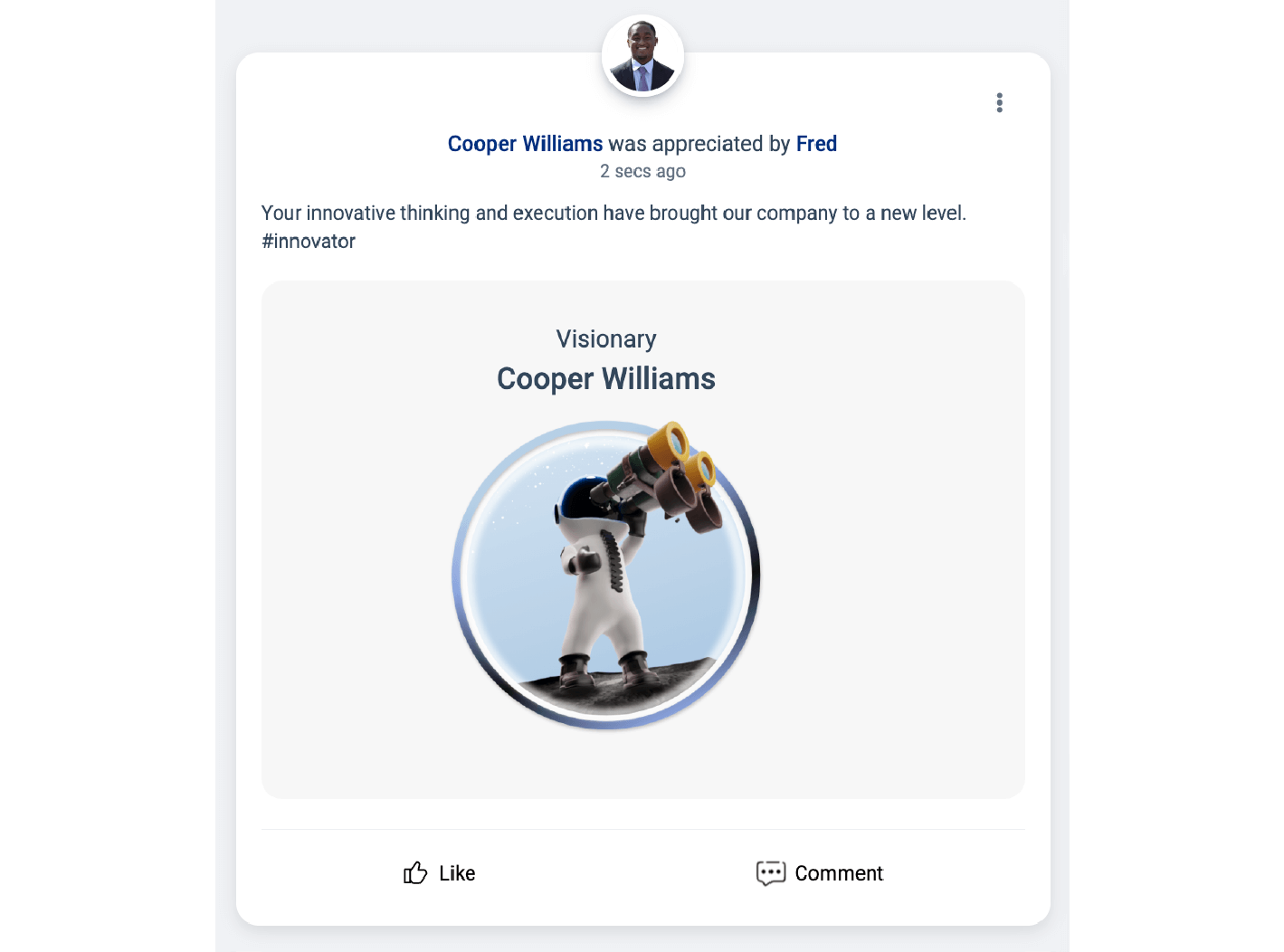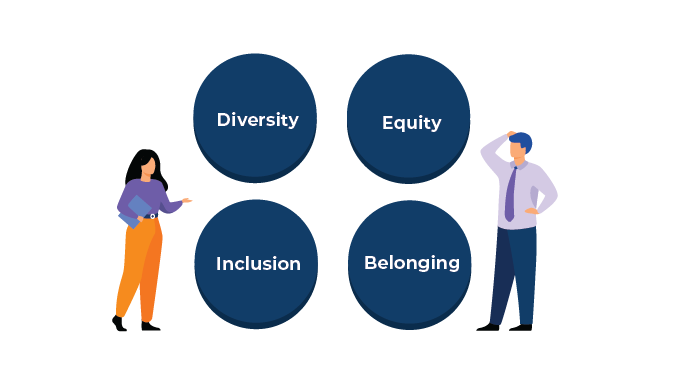What is Diversity, Equity, Inclusion, and Belonging (DEIB)
Diversity, Equity, Inclusion, and Belonging (DEIB) are more than just buzzwords in today's workplace. They are fundamental principles that drive organizational success and societal progress.
DEIB encompasses a broad range of concepts and practices. It is aimed at creating an environment where everyone, regardless of their background, feels valued, respected, and included.
In this blog, we will explore the meaning and importance of DEIB. We’ll also look at various strategies to foster a culture of diversity, equity, inclusion, and belonging in the workplace.
So, let’s delve into the heart of DEIB and discover its transformative power in driving a positive company culture.
Key Takeaways
- Learning about Diversity, Equity, Inclusion, and Belonging
- Best Practices for Maintaining Diversity in the Workplace
- What are the Strategies for Promoting Equity in the Workplace?
- How to Promote Inclusion & Belonging in the Workplace?
Diversity

According to a Glassdor Report, 2 out of 3 job candidates seek companies that have diverse workforces.
Diversity refers to the presence of differences among individuals within a group or organization. It encompasses the varied characteristics, backgrounds, and perspectives that make each employee unique.
A diverse workforce includes people from different races, ethnicities, genders, ages, religions, abilities, sexual orientations, socioeconomic backgrounds, and more.
Different Types of Diversity
1. Cultural Diversity
Cultural diversity refers to the variety of cultures represented in a group or organization. It includes differences in language, traditions, beliefs, and values.
Companies with culturally diverse teams can tap into a broader range of perspectives, experiences, and ideas that can give them a competitive edge. It leads to greater innovation, better problem-solving, and improved team collaboration.
For instance, a team composed of members from various cultural backgrounds will approach challenges in new ways compared to a homogenous team.
2. Gender Diversity
Gender diversity focuses on the presence of various gender identities. It goes beyond traditional genders (male and female) and include non-binary, genderqueer, and genderfluid individuals.
Organizations with greater gender diversity, especially at the leadership level, tend to be more profitable and productive. Bringing more women into senior roles also sends an important message about gender equality.
For instance, appointing qualified women to boards and executive positions demonstrates a commitment to tapping top talent regardless of gender.
3. Sexual Orientation
Sexual orientation refers to an individual’s emotional, romantic, or sexual attraction to other people. It is a deeply personal aspect and is not the same as gender identity.
It encompasses the range of sexual orientations that individuals may identify with, including heterosexual, homosexual, bisexual, pansexual, and asexual orientations.
Fostering an inclusive environment for LGBTQ employees has been linked to positive business outcomes like improved talent retention. Therefore, many leading companies celebrate Pride Month and proactively support LGBTQ staff through progressive policies and benefits.
4. Religious Diversity
Religious diversity refers to the variety of religious beliefs and practices within a group or organization. It includes different religions, such as Christianity, Islam, Hinduism, Buddhism, Judaism, and many others.
Respecting religious diversity can create a more inclusive environment where people of all faiths feel comfortable expressing their beliefs.
Organizations can show religious diversity by enabling employees to take time off for religious holidays. Additionally, accommodating employees’ religious practices around observances, clothing, prayer times etc. shows that companies value all faith backgrounds.
5. Racial Diversity
Racial diversity focuses on the representation of different races and ethnicities. It enriches the workplace by bringing together individuals with unique experiences and perspectives.
Embracing racial diversity helps organizations to be more creative and innovative. When people from different racial backgrounds collaborate, they bring a variety of ideas and approaches to problem-solving, leading to more innovative solutions.
Best Practices for Promoting and Maintaining Diversity
1. Increase Diverse Representation
To promote diversity effectively, it's crucial to increase the representation of diverse groups across all levels of your organization.
This means actively seeking out candidates from underrepresented backgrounds when hiring and promoting employees. By doing so, you create a more inclusive workplace.
Let’s look at few strategies that organizations can implement to increase diverse representation:
-
Inclusive Job Descriptions: Ensure that job descriptions are inclusive and appeal to a diverse range of candidates.
-
Diverse Interview Panels: Include individuals from diverse backgrounds in the interview process to ensure a fair and unbiased selection process.
-
Diversity Training: Provide training to hiring managers and employees involved in the recruitment process to raise awareness about unconscious bias.
Recommended Resource: Diversity Hiring: 7 Effective Ways For Recruiting Diverse Employees
2. Spotlight Diverse Success Stories
Highlighting the achievements of employees from diverse backgrounds can inspire others and create a more inclusive culture. By celebrating these success stories, you show that diversity is valued.
Organizations can regularly feature stories of successful employees or leaders from diverse backgrounds in internal communications to inspire and motivate others.
3. Conduct Regular Diversity Audits
Regularly auditing your diversity efforts can help identify areas for improvement and ensure that your policies and practices are effective. It also helps you identify areas where diversity initiatives are working well, and areas needing improvement.
To conduct a successful audit, organizations should first define clear objectives, including the aspects of diversity they want to assess. Next, they should gather relevant data on workforce demographics.
Based on the findings, organizations should develop actionable recommendations and create an action plan to implement these recommendations.
4. Diversity Training
Diversity training is a critical component of promoting diversity in the workplace. By providing ongoing training to employees and managers, organizations can increase awareness of the importance of diversity.
The training can include topics such as unconscious bias, cultural competency, and inclusive leadership. Through diversity training, employees and managers can understand how unconscious biases can impact their decision-making and interactions with others.
They can also learn strategies for creating a more inclusive environment, such as actively listening to diverse perspectives and fostering open communications.
Equity

Equity in the workplace is about ensuring that every employee, regardless of their background or circumstances, has a fair and equal chance to succeed.
It also means providing all employees with the resources, support, and opportunities they need to perform their jobs effectively and advance in their careers.
Strategies for Promoting Equity in the Workplace
1. Conduct Regular Pay Audits
Regular Pay audits can also increase transparency and trust among employees, leading to higher job satisfaction and retention. It helps ensure that employees are paid fairly for their work, regardless of gender, race, or other factors.
Through pay audits companies can pinpoint areas where inequities may be present and take corrective action to address them. As a result, it demonstrates the organization's commitment to fairness and equality.
Additionally, regular pay audits can help to increase transparency and trust within an organization. When employees see that their company is actively monitoring and addressing pay equity issues, they are more likely to trust that they are being treated fairly.
2. Offer Flexible Work Arrangements
Offering flexible working arrangements, such as flexible work hours and work from home options, is a valuable strategy for promoting equity in the workplace. This approach recognizes that employee's diverse needs and responsibilities outside of work.
For caregivers, such as parents or those caring for the elderly, flexible working hours can make it easier to balance work and caregiving duties. They can adjust their schedules to accommodate their responsibilities without sacrificing their job performance.
Additionally, individuals with disabilities can also benefit from flexible work arrangements.
For example, someone with a mobility impairment may find it challenging to commute to the office every day. Remote work option can provide them with the flexibility they need to work comfortably and effectively from home.
3. Provide Equal Access to Development Opportunities
Providing equal access to development opportunities ensures that all employees have a fair chance to enhance their skills, knowledge, and career prospects. This includes access to training programs, mentorship, and opportunities for advancement within the organization.
Training programs are also essential for helping employees develop new skills and stay competitive in their fields. However, it's important to ensure that these programs are accessible to all employees, regardless of their location or work schedule, to promote equity.
4. Survey and Address Equity Gaps
Regularly conducting employee surveys about their experiences and perceptions of equity in the workplace can help companies identify and address potential gaps. The surveys help organizations to take proactive measures against disparities or inequities.
By collecting feedback directly from employees, organizations can gain valuable insights into the factors that may be contributing to inequity. This information can then be used to develop strategies and implement new policies or practices to promote equity in the workplace.
Inclusion

Inclusion is the key to unlocking the full potential of a diverse workforce. It allows organizations to leverage the varied skills, backgrounds, and perspectives of their employees to drive success and innovation.
An inclusive workplace actively involves their employees in decision-making processes, policies, and practices. When employees feel included, they are more likely to share their ideas and contribute to the organization's goals.
Effective Strategies for Promoting Inclusion in the Workplace
1. Support Employee Resource Groups (ERGs)
Employee Resource Groups (ERGs) are an essential component in fostering an inclusive workplace. These groups are often formed based on shared characteristics such as gender or ethnicity and serve as a support network for employees.
For instance, a women's leadership group can provide a forum for female employees to discuss challenges they face in the workplace.
Similarly, an LGBTQ+ alliance group can offer a safe space for LGBTQ+ employees to connect with each other and share experiences.
By tapping into the collective experiences and perspectives of ERG members, organizations can gain a better understanding of different employee groups.
2. Establish Zero-tolerance Policy for Discrimination
Establishing a zero-tolerance policy for discrimination is a critical step towards promoting inclusion in the workplace. Such a policy sends a clear message to employees that show discriminatory behavior.
A zero-tolerance policy should be clearly communicated to all employees through the employee handbook, training programs, and company policies. It should outline the behaviors considered discriminatory and the consequences for engaging in such behavior.
3. Encourage Collaboration
Encouraging collaboration among employees from diverse backgrounds is a powerful way to promote inclusion in the workplace.
When employees from different backgrounds work together on projects and initiatives, they learn from one another and gain new perspectives. They often approach problems from different angles and think creatively.
Collaboration also helps build stronger relationships among team members. While working together they develop a greater appreciation for each other's strengths and contributions, fostering a sense of camaraderie and teamwork.
Additionally, collaboration can help break down barriers and stereotypes that may exist among employees from different backgrounds. By working closely together, employees have the chance to form personal bonds and dispel misconceptions.
4. Spotlight Cultural Celebrations
Organizations can create a sense of belonging by recognizing and celebrating cultural diversity through celebrations such as Black History Month, Pride Month, or Diwali.
Encouraging employees to participate in these cultural celebrations can help break down barriers between people of different backgrounds. It also helps to create a sense of unity among employees, as they come together to celebrate and learn from one another.
Overall, recognizing and celebrating cultural diversity in the workplace can help to create a more inclusive and welcoming environment for all employees.
Belonging

Belonging in the workplace refers to the feeling of being accepted, included, and valued as a part of the organization. It means feeling connected to your colleagues and the company culture in a way that allows you to be your authentic self.
A sense of belonging can arise from shared values, mutual respect, and the opportunity to contribute meaningfully to the organization's goals. It is a vital aspect of employee well-being and engagement, leading to increased overall productivity.
Effective Strategies for Promoting a Sense of Belonging in the Workplace
1. Create a Sense of Purpose
According to a report almost 80% of employees expect their team leader to implement and improve DEIB initiatives to create meaningful change at work.
Creating a sense of purpose in the workplace involves ensuring employees understand how their roles and responsibilities contribute to organizational goals.
When employees can see the direct impact of their contributions, they are more likely to feel a sense of belonging and fulfillment in their work.
By aligning individual roles and responsibilities with the company's larger objectives, organizations can help employees see the value in their work.
Additionally, leaders should also take the time to connect with employees on a personal level, helping them see the significance of their contributions. This can lead to increased motivation and overall employee engagement.
2. Reward and Recognize Employees
Recognizing and rewarding employees for their contributions is a powerful way to foster a sense of belonging in the workplace.
Employees who feel that their hard work and achievements are appreciated are more likely to feel valued as a team member. This, in turn, leads to a stronger sense of belonging.
Employee Recognition can take many forms, from a simple thank you or shout-out to more formal rewards such as bonuses or promotions. The key is to make the recognition personal and meaningful. This shows employees that their efforts are not just noticed but valued.

Source: Vantage Rewards
3. Promote Work-Life Balance
Promoting work-life balance is essential for enabling employees to thrive both at work and home. It involves providing employees with the resources and flexibility to effectively manage their work responsibilities while also taking care of their personal well-being.
Employees who are encouraged to prioritize their well-being are more likely to experience greater job satisfaction and a stronger sense of belonging. This is because they feel that their employer cares and recognizes the importance of their personal lives outside of work.
For instance, you can promote work-life balance by allowing employees to work remotely or from home as needed. This flexibility helps employees better manage their work and personal commitments.
4. Seek Feedback and Act on it
Seeking feedback from employees and acting on it is not just a good practice—it's a crucial strategy in fostering a sense of belonging.
When employees know that their opinions matter and that their feedback is being used to improve the work environment, they are more likely to feel valued.
To effectively seek feedback, organizations can use a variety of methods, such as employee surveys, focus groups, or one-on-one meetings. These feedback mechanisms can gather constructive feedback from employees about their experiences and concerns.
However, once the feedback is collected, organizations must act based on the input received. This may involve making changes to policies, procedures, or practices to address issues raised by employees.
Importance of Diversity, Equity, Inclusion, and Belonging in the Workplace

1. Better Decision-Making
Diversity, Equity, Inclusion, and Belonging (DEIB) in the workplace lead to better decision-making. When teams include individuals from various backgrounds, they bring different perspectives and insights to the table.
The diversity of thought leads to more informed and effective decisions. Moreover, tapping into varied viewpoints leads to creative ideas and solutions.
For instance, imagine a marketing team working on a new campaign to drive leads. A diverse team can offer unique insights into how the campaign might be received by various target audiences. This diversity can lead to a campaign that resonates with a broader range of customers.
2. Enhances Creativity
A diverse and inclusive environment encourages creativity and out-of-the-box thinking. When employees feel valued and included, they are more likely to share their ideas freely. This openness leads to a more dynamic and creative work environment, where new and innovative ideas can flourish.
To promote and enhance creativity organizations can create a safe space for sharing ideas, where all team members feel comfortable expressing themselves. They can also celebrate and reward innovation and creativity to reinforce its importance in the workplace.
3. Boosts Company Reputation
Companies that prioritize DEIB have a positive reputation. Customers and partners are increasingly looking to support businesses that demonstrate a commitment to DEIB initiative. A strong reputation in these areas can attract new customers and partners.
For instance, a company known for its diverse and inclusive work culture may appeal to job seekers looking for a welcoming and supportive environment. This positive reputation can help the company attract top talent in a competitive job market.
4. Promotes Social Responsibility
At its core, DEIB is about doing the right thing for marginalized groups and ensuring fairness in society. When workplaces proactively support DEIB efforts they demonstrate a commitment to social responsibility and ethical practices.
It is crucial to note that businesses today use their platforms not just for profit but also for positive impact. This commitment to social responsibility not only enhances employee morale and loyalty but also makes a positive impact beyond the workplace.
Challenges of Diversity, Equity, Inclusion, and Belonging

1. Resistance to Change
Many employees and leaders may resist DEIB initiatives due to the fear of addressing sensitive topics, or skepticism about the benefits. Leaders may worry about lowered productivity or divisions among staff.
However, growth depends on progress. Organizations can overcome this resistance with open communication, genuine empathy, and initiatives tailored to employees' needs. They can also host regular town hall meetings or forums where employees can openly discuss DEIB topics.
2. Ineffective Policies
A well-intended DEIB policies are the foundation of a diverse, equitable, inclusive, and belonging workplace. But having these policies is not enough, organizations should work towards introducing them effectively.
Even with well-intentioned policies, they may be ineffective if not properly implemented and monitored. Therefore, to ensure that policies are useful, organizations should conduct regular audits to assess their impact.
They should also provide training to ensure understanding and solicit feedback from employees to identify areas for improvement.
3. Token Hiring Practices
Token hiring practices refer to the act of hiring employees primarily to fulfill diversity quotas. It creates a superficial appearance of inclusivity without genuine commitment and can lead to resentment among employees.
For employees from underrepresented backgrounds, this approach can foster feelings of exploitation as they may perceive that their hiring is based more on meeting quotas rather than their qualifications. This can undermine their sense of value and belonging within the organization, leading to disengagement and reduced morale.
However, colleagues may question the abilities and qualifications of those hired through token practices, casting doubt on their competency.
Therefore, to truly promote DEIB initiative, organizations must focus on genuine efforts that prioritize merit, support, and inclusivity for all employees.
4. Lack of Accountability
DEIB policies can be meaningless without accountability. Leaders play a crucial role in this regard, as they must not only endorse these policies but also embody the behaviors they promote.
This includes demonstrating respect for all individuals and actively listening to diverse perspectives. By modeling these behaviors, leaders set the tone for the entire organization and inspire others to follow suit.
Organizations can also provide training for managers on how to address DEIB issues effectively and establish regular reviews of progress towards DEIB goals.
Moreover, implementing a zero-tolerance policy for discrimination and harassment ensures accountability in the workplace. When employees see that there are consequences for inappropriate behavior, they are more likely to follow DEIB policies and be respectful in the workplace.
Differences between Diversity, Equity, Inclusion, and Belonging (DEIB)

1. Difference Between Equity and Equality
| Equity | Equality |
|---|---|
| Equity involves distributing resources based on need to ensure fairness. | Equality demands things be divided evenly. |
| Focuses on fairness and justice, providing resources based on individual needs. | Focuses on treating everyone the same regardless of their circumstances. |
| Equity focuses on providing resources based on individual circumstances and needs. | Equality focuses on providing the same resources and opportunities to everyone. |
| Equity recognizes that different individuals may require different levels of support to achieve equality. | Equality assumes that everyone starts from the same place and needs the same support to succeed. |
2. Difference Between Diversity and Equity
| Diversity | Equity |
|---|---|
| Diversity focuses on the variety of differences, such as race, gender, age, religion, sexual orientation, etc | Equity focuses on ensuring everyone has the same opportunities and resources, regardless of their differences. |
| Diversity is about acknowledging and celebrating differences. | Equity involves ensuring equal opportunities despite differences. |
| The goal of diversity is to create a diverse workforce or community. | The goal of equity is to create a fair and just society or organization. |
| Diversity often focuses on increasing the representation of underrepresented groups. | Equity focuses on addressing the underlying causes of disparities and ensuring fairness. |
3. Difference Between Inclusion and Belonging
| Inclusion | Belonging |
|---|---|
| Inclusion is the act of ensuring that all individuals are welcomed, respected, and supported. | Belonging is the feeling of being accepted, valued, and included. |
| Inclusion creates an environment where individuals can bring their authentic selves to work. | Belonging is about individuals feeling that their identity and contributions are valued and respected. |
| Inclusion focuses on accepting differences among individuals. | Belonging focuses on celebrating differences to create a sense of unity and connection. |
| Inclusion is often measured objectively, such as through diversity metrics and representation numbers. | Belonging is a subjective experience that varies from individual to individual based on their feelings of acceptance. |
4. Difference Between DEI and DEIB
| DEI | DEIB |
|---|---|
| DEI focuses on Diversity, Equity, and Inclusion. | DEIB includes an additional focus on fostering a sense of belonging. |
| Aims to ensure all employees are treated fairly and respectfully. | Aims to create an environment where all employees feel valued and included. |
| Success is measured by diversity metrics and inclusion efforts. | Success is measured by the sense of belonging and inclusivity felt by employees. |
| DEI programs may focus on increasing diversity in employee resource groups. | DEIB programs may focus on ensuring that those groups are inclusive and welcoming to all employees. |
Conclusion
In conclusion embracing diversity, equity, inclusion and belonging (DEIB) are integral for any organization that wants to thrive in today's world. Organizations can only unlock the full potential of their workforce by fostering an environment where every individual feels valued and empowered.
While the journey toward DEIB may be challenging, the rewards are boundless. So, start building a workplace where everyone feels empowered to bring their best selves to work.


















